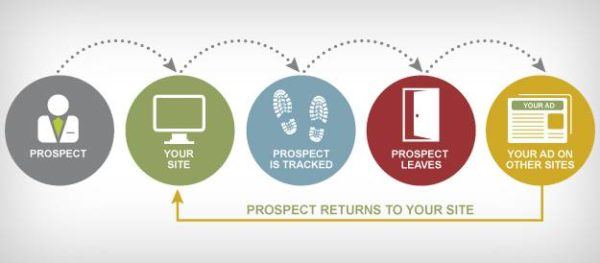How Does Remarketing on Google AdWords Work?
by Aden Andrus • January 25, 2018
Remarketing (aka, retargeting) is an advertising option that allows you to deliver targeted ads to people who visited your website…and didn’t convert. Not everyone who comes to your site is ready to convert today, so remarketing is a great way to stay in front of potential customers while they make up their minds.
There are several remarketing platforms out there, but Google remarketing remains one of the most powerful remarketing weapons in the online marketer’s arsenal. It has massive reach and a suite of options you can use to deliver the right message at the right time to the right person.
In this article, we’re going to take an in depth look at what Google remarketing is, how it works and how to get the most out of your remarketing campaigns.
What is Google Remarketing?
The basic concept behind Google remarketing is fairly simple: people don’t always buy the first time they see something they like, but if you can stay in front of them, they might the second time…or the third time…or the…
A Real-World Example
For example, let’s say you own a media store at the local mall. I come in and see a new movie that’s just come out that I loved in theaters. I grab it and head towards checkout when all of a sudden my daughter suddenly bolts out of the store and disappears into the mall (this may or may not be based on a true story).

As you can probably imagine, I immediately put the movie and race after my daughter, hollering at the top of my lungs as I try to catch her. By the time I finally find her, I’m done with the mall. The two of us are heading home—right now!
Now, do my daughter’s hijinks have anything to do with the quality of your product, your price or even my interest in buying it? Absolutely not!
Did I want to buy it? Yes. Was the timing right for me to buy it? No.
Unfortunately, for a brick-and-mortar business, a customer who walks out the door without making a purchase is often lost forever. You don’t know who they are and you have no way of reminding them about that purchase they were considering.
Let’s Try that Again
Online, however, the story plays out a little bit differently. Let’s say you run the same media outlet, but your store also has an online presence. This time, I’m looking for a good deal on that new release and I end up clicking on one of your ads. You’ve got the movie I want, so I add it to my cart.
Then, just before I click “Checkout”, I decide to do a little price shopping. I check out some competitors’ sites for a few minutes before I’m interrupted by a work email. It’s something pressing that I need to take care of right now and by the time I wrap things up, a couple of hours have passed and I’ve forgotten about the movie I was about to buy.
Once again, you’ve missed out on a potential sale. But this time, the story doesn’t end here.
The next day, I’m online and I see an ad for that movie I like…with a 20% off coupon. All of a sudden, you’ve got my attention. Now that I can get the movie I wanted at a discount, I’m all yours. I hop back on your site and buy that movie, along with a couple of others to take full advantage of the coupon. That’s a win for remarketing!
The Power of Remarketing
To put it simply, remarketing is using what you know about your potential customers (when they visited your site, what they looked at, how long they stayed, what they looked at, whether they put something in their cart, how many times they’ve come back, etc) to stay on their radar until they make a purchase.
In essence, it’s a marketer’s dream. Your audience tells you what they want and then you use that information to give them what they’re looking for. Obviously, it would be better if they converted the first time around, but if at first you don’t succeed…remarket!
Here are just a few ways remarketing can help you get more out of your online advertising:
- Lower cost-per-click
- Improved conversion rates
- Cheaper cost-per-impression
- Low-cost branding
- Higher return-on-investment (ROI)
If you’ve ever been followed around by ads from a site for days, weeks or months, you’ve experienced Google remarketing. Now, it’s time to put Google remarketing to work for you.
How Google Remarketing Works
Google remarketing allows you to run remarketing ads on the Google Display Network (including Gmail Sponsored Promotions), YouTube and even the Google Search Network. Altogether, that gives you the ability to remarket to over 90% of the internet.
Getting Started with Google Remarketing
The good news is, it’s quite easy to set up a remarketing campaign in AdWords. Basically, all you have to do is add the Google remarketing tag (aka, pixel) to your site or upload an email list and create some ads.
If you’ve never done this sort of thing before, this video will walk you through the process:
Honestly, the most challenging part of creating a Google remarketing campaign is actually making your ads, but you can either use Google’s Display Ad Builder to create basic ads or our AdWords display ads template to quickly generate your own custom-made remarketing ads (click here for the template and a tutorial on how to use it).
As a side note, not all remarketing ads are banner ads. If you are running paid search ads on AdWords, you can use remarketing lists for search ads (RLSAs) to customize your keywords, bids and ad copy for people who have already visited your site. RLSAs fall a bit outside of the scope of this article, but we’ve used RLSA campaigns to increase sales by 129%, so if you’re running paid search ads, they’re worth trying.
Overall, it’s so easy to set up a remarketing campaign on AdWords that it would be a shame not to use Google remarketing.
Remarketing Pixels vs Remarketing Lists
Now it’s time to get into the details of how Google remarketing campaigns actually work. Remarketing campaigns target people in one of two ways: 1) using a pixel and 2) using a list. This is important, because how you choose to target people will affect which types of campaigns you run and what kind of ad content you should use.
Pixel-Based Remarketing
Most remarketing uses pixels to identify people who have visited your website. A “pixel” is basically a short piece of code you place onto your website (or a specific page on your website).When someone arrives on your site, the pixel drops a cookie onto their browser that tracks them wherever they go online.
For a brief explanation of how remarketing cookies work, check out this video:
If that visitor happens to fall into the 90% of internet traffic that visits websites where Google displays ads, you can bid to have your ads show up. It is a bit of a bidding war, but because your targeting is so specific and remarketing clicks are so much cheaper, there’s a pretty good chance that your ads will be shown.
Pixel-based remarketing is great because it’s instantaneous. The moment someone lands on your site or a specific page on your site, they get “cookied” and can start seeing your ads. In addition, you also know that your target audience was interested enough in your site to visit it and how recently they visited—all useful information you can use to create an effective remarketing strategy.
List-Based Remarketing
Another way to target people for remarketing is to use your existing customer lists. List-based remarketing uses emails to track and target your ads. As long as the email a customer gives you is linked to the Google profile they are using, Google can show them your remarketing ads.
The great thing about list-based remarketing is that you get a lot more control over who you target. With pixel-based remarketing, you don’t really know who you are targeting. Sure, you might know that they visited 4 pages on your site and had X item in their shopping cart, but you don’t know if they are a repeat customer or a competitor trolling your site.
However, with list-based remarketing, you can upload lists of existing or previous customers and create ad campaigns around those lists and their needs. In fact, the more data you have on the people in your email list, the more specific and effective your remarketing can be.
But, of course, that’s all assuming that you have a good match rate with your emails. With a pixel-based remarketing list, if someone has your cookie on your browser, you can target them. With an email-based remarketing list, if 80% of the people on your list don’t have an active Google profile associated with the email they gave you, you can only target 20% of the people on your list.
Both list-based and pixel-based remarketing lists have their purposes (which we’ll get into later), so it’s usually a good idea to use both. But, it’s important to understand both types and how to effectively use them to really get the most out of your Google remarketing campaigns.
Google Remarketing Best Practices
Of course, knowing how Google remarketing works and making it work for your business are two very different things. To really make the most of your remarketing campaigns, here are a few things you’ll want to keep in mind.
1. Segment Your Audiences
People visit your site for very different reasons. You might have visitors who want to make a purchase, simply like your blog or even ended up on your site by complete accident (believe me, it happens more than you might think).
It doesn’t make a whole lot of sense to use the same message with all of these different people, does it?
By setting up different criteria (pages visited, time on site, geographic location, demographics, etc) or using different pixels on different pages of your site, you can segment your audience and create specific messaging that addresses the specific needs and interests of that particular segment.
With audience segmentation, you can target people who leave items in their shopping cart with one set of ads and people who read your blog with a completely different set of ads. That way, both segments get ads that help move them a little closer to making a purchase.
2. Decide Your Frequency
There are two basic schools of thought when it comes to frequency caps. To avoid irritating your potential customers, some people recommend capping ad impressions at 17-20 ads per person per month.
On the other hand, some advertisers take a very different approach to remarketing. If someone just visited your site, they’re probably very interested in what you’re selling, so these advertisers recommend getting as many ads as possible in front of these visitors.
Personally, I recommend something of a hybrid approach between these two schools of thought.
With most remarketing platforms and services, you can set up campaigns based on how long it has been since someone visited your site. Using this feature, you can inundate potential customers with remarketing ads for the first 1-2 weeks after they visit your site. Then, as time goes on, the likelihood that they will click and convert starts to go down, so you can decrease the frequency of your ads.
This hybrid strategy allows you to strike while the iron is hot…without irritating people in the long run.
Regardless of how you choose to approach frequency caps, however, it’s almost always a good idea to keep running remarketing ads for as long as possible. You never know when someone will be ready to buy and—at the very least—it’s a cheap way to build brand recognition.
3. Use a Burn Code
There’s something remarkably irritating about seeing a remarketing ad…right after you just purchased what the company is advertising. Fortunately, you can easily avoid this problem in your own campaigns by using a burn pixel.
By adding a pixel to your thank you page (or whatever page users arrive on after converting), you can exclude them from your normal remarketing campaigns. Setting up a burn pixel sets you up to do some pretty cool additional things, too, but we’ll get into those in the next section.
4. Set View-Through Conversion Windows
Remember when we were talking about the different types of goals you can set for your remarketing campaigns? Building awareness is a great goal, but it can be hard to measure the impact of brand awareness.
One way to track the impact of your brand awareness campaigns is to set view-through conversion windows. Essentially, view-through windows allow you to link someone seeing your ad to their conversion—even if they never click on a remarketing ad!
Depending on your platform or service, you can set view-through conversion windows for a variety of durations. In general, however, I recommend keeping your window to 1 week or less. A good remarketing ad will make an impression, but it’s still a banner ad, so it probably doesn’t affect people for very long.
Can you remember any of the banner ads you’ve seen this week? (if you can, surprise me and let me know in the comments).
While a good remarketing ad can generate the billboard effect, attributing a sale to a remarketing ad impression from 6 weeks ago doesn’t make a whole lot of sense. However, if someone sees a remarketing ad in the morning and converts in the afternoon, there’s a decent chance that the ad influenced their decision to some degree.
5. Rotate Your Ads
Let’s be honest, banner blindness is real. Even when you’re running remarketing ads, where your audience has already expressed an interest in your business and is more likely to notice your ads, banner blindness will eventually set in if you don’t regularly rotate your ads.
In fact, according to a study by ReTargeter, clickthrough rates typically fall by 50% over the first 5 months of a campaign. So, if you don’t change things up every few months, you could be missing out on a ton of conversions.
The easiest way to avoid this problem is to run regular A/B tests on your remarketing ads. By testing new imagery and copy on a regular basis, you can keep things fresh and figure out what sort of messaging really works best for your audience. It’s a double win!
Take Your Remarketing to the Next Level
Getting your remarketing set up correctly is great, but if you really want your campaigns to deliver awesome results, you have to get inside the head of your target audiences.
Every potential customer is on a buyer journey, and every buyer journey is different. If you want to use remarketing to lead potential customers to the point where they are ready to buy, you need to craft marketing messages that match where your customers currently are—not just where you think they are.
Here are four ways to do that:
1. Resolve Their Concerns
Often, people aren’t ready to convert because they still have unanswered questions or concerns about converting. They might not be ready to spend what you’re asking. They might not be ready because they feel nervous about giving you their personal information. They might not be ready to make the time commitment that comes with signing up.
Whatever the reason, if you know that most of your audience isn’t ready to convert because of a specific concern, remarketing can be a great way to address that concern.
Wix does an excellent job of this with one of their remarketing videos. Wix provides website design services, but most people believe that creating a website will take a ton of time and energy. Since they aren’t ready to commit that time and energy, they don’t convert.
https://www.youtube.com/watch?v=sIgv3tTYYqQ
To address this point of concern, Wix runs a remarketing video that walks viewers through the process of designing a site on their platform in just one minute and seven seconds. It’s a slick video, but even more important than the video itself is its message: designing a website with Wix is a quick process.
2. Cut Your Prices
Often, one of the biggest reasons why people aren’t ready to buy is because they aren’t comfortable with the price. 94% of people invest time into comparison shopping, so the odds are that most of your potential customers are hoping they can get what you’re selling for a cheaper price.
Is it any wonder that discounts are one of the most widely used sales tactics?
Discounts get directly at the heart of your potential customers’ pricing concerns. Throw in a little sense of urgency (“Offer Valid Until August 31st”) or exclusivity (“Like Our Page and Get 15% Off”) and you stand a good chance of nudging a potential customer into the “ready to buy” arena.
Cabela’s does an excellent job of this with their remarketing ads. For example, check out this ad:

If pricing on their products is a concern, Cabela’s just made it clear that they are willing to sell a lot of stuff for up to 40% off—as long as you buy soon. So, if price really is important to you, you need to buy now!
3. Make Things Simple
Another big reason why people aren’t ready to buy is because what you’re selling is just part of a bigger problem they need resolved. If you buy a new phone…you also buy a cover. You can’t just get your oil changed…you also need your brakes checked (and the tires….and the lights…and the…ad infinitum). If you sign up for cable, you need someone to set it up.
So, if they buy what you’re selling, they have to figure all of the rest of it out, too. That’s a headache—one that can keep them from converting.
Fortunately, remarketing is a great way to address these concerns, especially if you happen to sell the solution(s)! For example, Maurices’ remarketing ads take a product you showed interest in and show it in combination with a variety of accessories:

Now, instead of having to figure out all the coordinating pieces you need to buy, you can buy a great looking outfit all at once. It makes things easier for you (and it makes more money for Maurices).
This tactic works great for ecommerce businesses, but can work just as well for almost any business. All you have to do is identify the “extras” your customers will probably have to buy and make it clear to your customers that if they buy from you, it’s a one-stop experience. Throw in a combo discount and you’re well on your way to getting people from “thinking about buying” to “ready to buy!”
4. Bring Them Back for More
Remember how I said that your burn pixel was good for more than just getting people out of your remarketing campaigns? Well, good remarketing convinces people who are ready to convert—but didn’t actually act during their first visit to your site—to convert. Better remarketing convinces people who aren’t ready to convert to convert.
The best remarketing convinces people who have converted to convert again.
Marketing doesn’t end with a sale. Sales may be the ultimate goal of marketing, but truly great marketing gets people to buy again and again. To pull this off, you really need to understand your buying cycle. If someone just made a purchase, they probably aren’t ready to buy again the next day. Give it a few weeks or months, though, and new needs or challenges can easily get someone ready to buy once again.
And, if your ads happen to be there when they are ready to buy, you’ve got a much better chance of up-selling or cross-selling your customers.
For example, if you are marketing a SaaS product and most of your customers upgrade after 3 months, it might be a good idea to run remarketing ads at about 2 months after someone signs up. That way, you can highlight the benefits of upgrading just as they start to realize that they need to upgrade. Now that’s awesome remarketing in action!
Conclusion
Google remarketing is an incredibly powerful way to keep your business and products in front of people who didn’t convert the first time they visited on your site. While in a perfect world, everyone would convert on their first visit, the simple fact of the matter is that things rarely work out that smoothly.
For many people, they will need to see your ads again…and again…and again before they convert.
Fortunately, Google makes it very easy to stay in front of your target audience until you finally win them over. Remarketing on Google is easy and affordable, but more importantly, it can have a big impact on the long-term success of your online marketing.
Hopefully, you should be well on your way to creating truly effective remarketing campaigns, but if you want some extra help, let me know here or in the comments! I’d be happy to take a look at things and give you some specific recommendations.
How do you use remarketing to build your business? Any tips you’d like to share?






